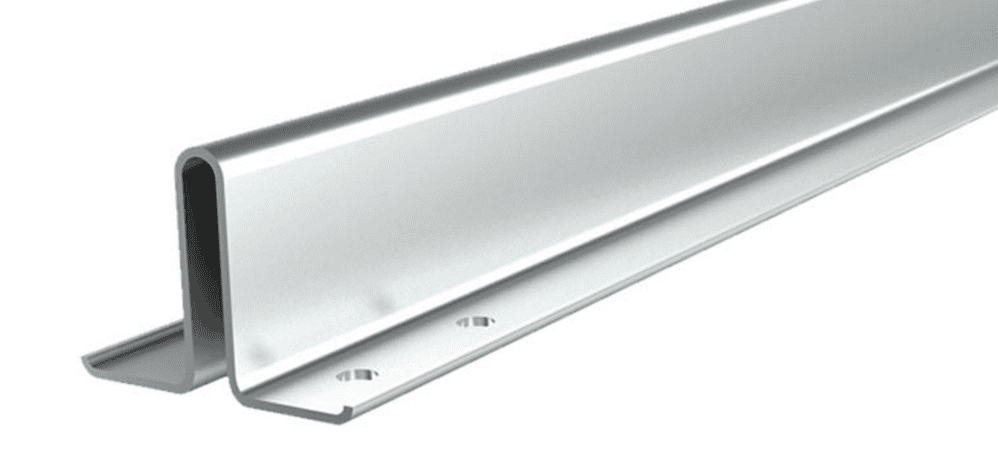When you think about keeping an elevator safe and running quietly, the guide rail stands out as a true unsung hero. That long, straight bar locks the cabin and its counterweight into a steady track so they slide up and down without wandering. Inside the lift business, technicians usually talk about two big families of guide rails: solid and hollow. Both coax the car to its floor, yet the way they are forged and welded steers each one toward a different job site.
In the coming lines, we will break down each type of guide rail, explain why they are compared, how they differ, and which one may cost more.
A solid guide rail starts life as a thick slab of high-strength steel-either cold drawn or hot rolled, and arrives with no inner voids. That dense metal creates outstanding rigidity, able to shrug off bending stress while keeping the car dead-centred in the shaft. A machine or grinder then polishes the outer faces until they gleam, allowing rollers and shoes to glide with almost ghostly ease. For decades, these solid rails have been the industry default and remain the first choice for lift builders tackling anything from a low-rise mall to a city tower. They comfortably cradle sprinting cars, bear hefty delivery payloads, and in harsh service conditions, rust or bend less than their rivals. As ever stronger and taller elevators appear, the solid rail keeps proving that sometimes the simplest is best.
A hollow guide rail is built from a tubular steel profile rather than a solid block of metal. The space running through the middle cuts down the weight, so movers, fitters, and even the elevator motor itself appreciate the relief. Designers sometimes add braces at the ends or corners to keep the rail sturdy and passengers safe. Because of that clever mix, hollow rails have become the go-to choice for today's light-duty elevator jobs. Handling and hanging the pieces is straightforward, a clear bonus when crews are racing against the clock. In low-rise blocks where trips are slow and loads modest, they present a budget-friendly, practical solution.
Solid and hollow rails each bring their pros and cons, so we compare them whenever a new shaft is on the drawing board. Selecting one rail type or the other can sway overall performance, safety margins, purchase cost, and the time needed to install. Every building is unique, and the final design must respond to lift height, car weight, passenger count, and a host of technical specs. Placing a heavy, solid rail in a small residential block could waste both steel and budget. Conversely, picking a slender hollow rail for a tall office tower hauling large crowds would likely lead to early wear and costly repairs.
The most obvious difference is the structure: solid guide rails are fully solid metal bars, while hollow guide rails are empty inside.
But there are other important differences, too:
Strength and Load Capacity: Solid guide rails are stronger and can carry more weight. They are better for high-speed and heavy-duty elevators. Hollow guide rails have lower strength and are best for light loads and slower speeds.
Weight: Hollow guide rails are lighter, which makes them easier to transport and install. This can save time and labor on-site.
Rigidity and Safety: Solid guide rails offer better rigidity, which means less vibration and smoother movement. They are also more reliable in emergencies, such as sudden stops or earthquake conditions.
Durability: Solid guide rails typically last longer and require less maintenance over time.
Application Range: Solid rails are suitable for high-rise buildings, hospitals, and freight elevators. Hollow rails are more common in low-rise residential buildings, small office buildings, or places where cost and ease of installation are more important than speed or load.
Generally speaking, solid guide rails cost more than hollow ones. This is because they use more raw material and require more work to manufacture. They are also heavier, which increases shipping costs. However, the higher price often comes with better long-term performance and reliability, especially in high-traffic or high-speed elevator systems.
Hollow guide rails are less expensive and may be a good option for budget-conscious projects. They reduce both material and transportation costs. But keep in mind that they are not suitable for every situation. Choosing a cheaper rail that doesn’t meet the building’s needs could lead to problems in the future.

Both solid and hollow elevator guide rails have their advantages and limitations. Solid guide rails offer higher strength, better stability, and are ideal for demanding applications. Hollow guide rails are lighter, more affordable, and easier to install, making them a good choice for small-scale or low-rise buildings.
When deciding between the two, it’s important to consider the type of building, the speed and weight of the elevator, and your budget. A well-informed choice will lead to a safer, smoother, and longer-lasting elevator system.
If you're unsure which guide rail suits your project best, it's always a good idea to consult with us, a professional elevator manufacturer.